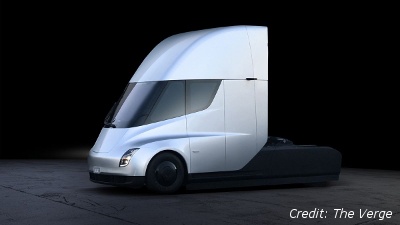Best in Manufacturing – November 26, 2017
Each Sunday, we publish a list of top articles and other content related to manufacturing in areas like quality control, product development, supply chain management, sourcing, auditing and law.
1. How will the Tesla Semi impact logistics and manufacturing?
This column isn’t called “Best in Logistics”. But still, the Tesla Semi is worth mentioning for the effects it could have on supply chains and manufacturing as a result.
Here are a few details on this beast of an electric truck:
- On a single charge, the fully loaded truck can travel 500 miles
- The truck can go from 0 to 60 mph in 5 seconds, and with a full load, from 0 to 60 mph in 20 seconds (compare that to 15 and 60 seconds, respectively, for a fully loaded diesel truck)
- The truck is equipped with an enhanced autopilot that can self-drive the truck
- A diesel truck costs around $1.51 a mile to operate, versus $1.26 for the Tesla Semi
For supply chains and importers, this truck could be a game changer.
With lower logistics costs, companies could take their savings and reinvest them to develop better products or provide better returns to shareholders. Autonomous driving could help improve utilization of fleets of semi-trucks, leading to greater efficiency and faster delivery of goods.
I personally look forward to the day that I can see these trucks of the future on the road. While I don’t want to drive one personally, seeing them operate will make me think we’re really entering a more futuristic society.
To see the announcement of the Tesla Semi and hear all the details, watch the video below:
Elon Musk Reveals the Tesla Semi Truck - Zakception, YouTube
2. Exposing the hype surrounding 3D printers
I won’t deny it: I’ve written several times about 3D printing. I’ve covered the jump from 3D to 4D printing, 3D printer spider bots and a 3D metal printer. Admittedly, I’ve given in somewhat (although not completely) to the hype generated by this new technology. But some people are more in the “negative camp” when it comes to where 3D printing stands right now.
The author of this featured article lists a few problems currently facing 3D printers that are seldom acknowledged, such as:
- Warping: even slight temperature changes can significantly affect an object as it’s being 3D printed
- Porosity: parts made by 3D printers are full of tiny holes, which can lead to leaks
- Prints not sticking to the bed: objects made with 3D printers do not adequately adhere to the print bed
- Way too manual: too much manual, additional effort is needed to operate 3D printers
- And more
What do you think about 3D printing – do you think these problems are significant or is 3D printing on track to live up to the hype? Let us know in the comments section below!
To read more about some of the challenges facing 3D printing, check out the featured article in the link below:
3D Printers are Overrated - Cabe Atwell, Machine Design
3. Your electronics produce obscene amounts of e-waste
Often times, people overlook all the work that goes into getting a product into a customer’s hands.
A tablet PC, for instance, might start its journey at a factory in Shenzhen, China, undergo a tablet PC inspection, travel across the sea to a warehouse in California and then end up at a retailer in Texas. Finally, after significant effort and planning, the product arrives on a retail shelf, ready for you to buy it.
 But this is the process of getting a product to you – what happens when you’re done with it? What happens once the product has left you?
But this is the process of getting a product to you – what happens when you’re done with it? What happens once the product has left you?
It’s actually quite sad in the case of electronics. Most electronics become “e-waste”. 20-50 million metrics tons of e-waste are discarded in the United States alone each year, and according to the American Environmental Protection Agency, only 12.5 percent are recycled.
The e-waste ends up in places like Ghana, Nigeria, China and India. The workers that process e-waste in search of the precious metals it contains are often exposed to toxic chemicals, which can lead to health complications.
Reducing e-waste and changing the manufacturing model
This featured article provides some suggestions for reducing your e-waste footprint, such as:
- Making a retailer take back the electronic item to properly process it
- Resisting the urge to always buy the latest gadget and chuck your old one
- Joining the repair economy to extend the longevity of products
- And more
By promoting awareness of sustainability, these suggestions can help move society more toward a cradle-to-cradle manufacturing model.
For importers and manufacturers that want to reduce their impact on the planet and show their customers that they’re committed to sustainability, it’s in considering these suggestions that they can start to design long-lasting, environmentally friendly products that produce less e-waste.
And as the world continues to consume electronics with a voracious appetite, e-waste recycling and a change in manufacturing mindset will become all the more important...lest we all be buried by piles of discarded computers, tablets, cell phones, keyboards and more.
To learn more about e-waste recycling, check out the full featured article in the link below:
Reduce, Reuse, Reboot: Why Electronic Recycling Must up Its Game - Lucy Siegle
4. How eye-tracking could lead to swifter training and improved safety
The first few weeks on the job aren’t always so easy. For some positions, there’s a steep learning curve and plenty to master before doing the job completely right. And within the manufacturing industry specifically, even the smartest hires might need time to become familiar with a certain process.
But with a little help from technology, training might go faster and workers might stay safer.
This featured article mentions the benefits of eye-tracking. When it comes to training, eye-tracking can monitor the performance of experienced workers and help transfer their skill to novices.
The article references the specific case of H&H Castings, which hopes that with eye-tracking technology,
Average training time is one full week, and we hope these insights and video will save us two days per employee. Ideally, this would save us 400 hours of training time per year in that department.
With more new workers aware of best practices from seasoned employees, it might be possible to avoid accidents and help quickly increase their efficiency to match that of other laborers.
Curious about eye tracking in manufacturing? Check out the featured article in the link below for more information:
Tobii Says Eye-tracking Could Improve Manufacturing Safety - Dean Takahashi, Venture Beat
5. Automation: a dirty word?
If you’re a factory worker in rural China making rice cookers, automation might not seem like such an appealing concept. If you work on the production floor at an auto factory in the U.S., automation might seem bad there as well, since from the point of view of those responsible for assembly, the technology threatens their livelihood. 
Despite the common feeling amongst workers, the political attitude toward automation in China versus America couldn’t be more different. China, through initiatives like Made in China 2025, is going ahead full steam on advanced technology like automation. In the U.S., by contrast, the Office of Science and Technology Policy went from having 135 staff in December 2016 to 45 right now.
China’s commitment to advanced manufacturing and automation is also exemplified through other means.
This featured article, for example, mentions the case of UBTech, based in Shenzhen. The robotics company has received investment not just from the private sector, but “big money” from the Shenzhen government too. Government support is helping the company build a factory in Yunnan. From one of UBTech’s representatives:
The land, the factory and even the office furniture are all offered by the government for free.
Compare this sort of treatment to the cuts in funding suffered by American robotics policy and the difference in automation strategies becomes more obvious. Maybe an even better way to reveal the difference is to merely mention “automation” during a White House policy meeting and gauge that outcome versus saying it in China.
To learn more about automation initiatives in the U.S. as compared to China, check out the featured article in the link below:
A Dirty Word In The U.S., 'Automation' Is A Buzzword In China - Asma Khalid, WBUR.org
We’re constantly scanning the web for top manufacturing stories and news. If you’d like to submit an article for consideration for our weekly Best in Manufacturing, send us a message and let us know.







